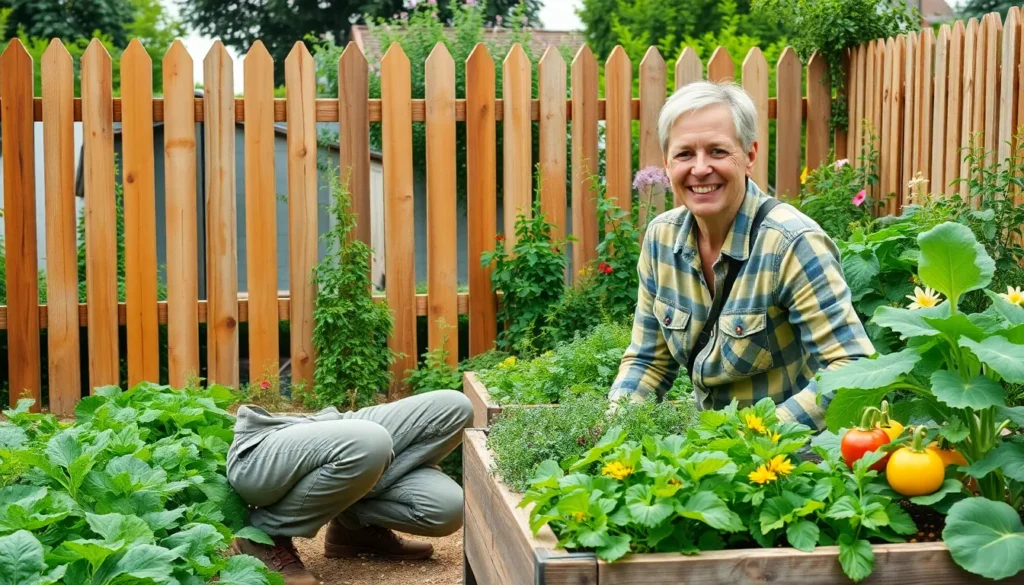Growing your own vegetables brings incredible satisfaction until hungry critters discover your garden paradise. We’ve all experienced that frustrating moment when rabbits deer or other pests turn our carefully tended crops into their personal buffet. That’s where a well-designed garden fence becomes your vegetable patch’s best friend.
The right fencing solution doesn’t just protect your harvest – it transforms your garden into a productive sanctuary. From traditional wooden barriers to modern wire mesh designs we’ll explore fence options that balance functionality with visual appeal. Whether you’re dealing with ground-dwelling rabbits or agile deer we’ve got strategies that work.
Smart fence planning saves both your vegetables and your sanity. The investment in proper garden fencing pays dividends when you’re harvesting pristine tomatoes untouched lettuce and perfect peppers instead of discovering nibbled stems and missing plants. Let’s jump into fence ideas that’ll keep your vegetable garden thriving season after season.
Traditional Wooden Fence Ideas for Your Vegetable Garden
Traditional wooden fences offer the perfect combination of functionality and natural beauty for vegetable garden protection. These time-tested barriers provide reliable defense against garden pests while creating an attractive border that complements your outdoor space.
Cedar Picket Fencing for Natural Protection
Cedar picket fencing stands as our top choice for vegetable garden barriers due to its natural pest-resistant properties. The aromatic oils in cedar wood naturally repel insects, slugs, and small rodents that typically damage garden crops. We recommend installing 4-foot cedar pickets with 2-inch spacing to prevent rabbits from squeezing through while maintaining adequate airflow for plant health.
Building cedar picket fences requires minimal maintenance since this wood naturally resists rot and weather damage. The installation process involves setting cedar posts 6-8 feet apart and attaching horizontal rails at the top, middle, and bottom. Staining or sealing cedar fencing every 2-3 years extends its lifespan to 15-20 years, making it a cost-effective long-term investment for garden protection.
Split Rail Fencing for Rustic Appeal
Split rail fencing creates a charming rustic boundary that works well for larger vegetable gardens and raised bed areas. This three-rail design typically stands 3-4 feet high and effectively deters deer when combined with additional wire mesh or netting. We often see gardeners choose split rail fencing for its easy installation process and authentic farmhouse aesthetic.
Constructing split rail fences involves setting posts 8-10 feet apart and sliding horizontal rails through pre-cut slots. The natural gaps between rails allow for easy access to garden areas while creating visual boundaries that define growing spaces. Adding chicken wire or hardware cloth between the rails transforms this decorative fence into an effective barrier against smaller pests like rabbits and groundhogs.
Bamboo Screening for Eco-Friendly Barriers
Bamboo screening provides an environmentally sustainable fencing solution that grows quickly and regenerates naturally. These lightweight panels install easily along existing fence lines or as standalone barriers, reaching heights of 4-8 feet depending on your garden’s protection needs. We appreciate bamboo’s natural flexibility, which allows it to withstand strong winds without breaking or requiring frequent repairs.
Installing bamboo screening involves securing panels to wooden or metal posts using zip ties, screws, or specialized clips. The dense weave of bamboo creates effective privacy screens while allowing filtered sunlight to reach plants near the fence line. Treating bamboo screens with natural sealers every 1-2 years prevents weathering and extends their useful life to 8-10 years in most climates.
Wire and Mesh Fence Solutions for Garden Security
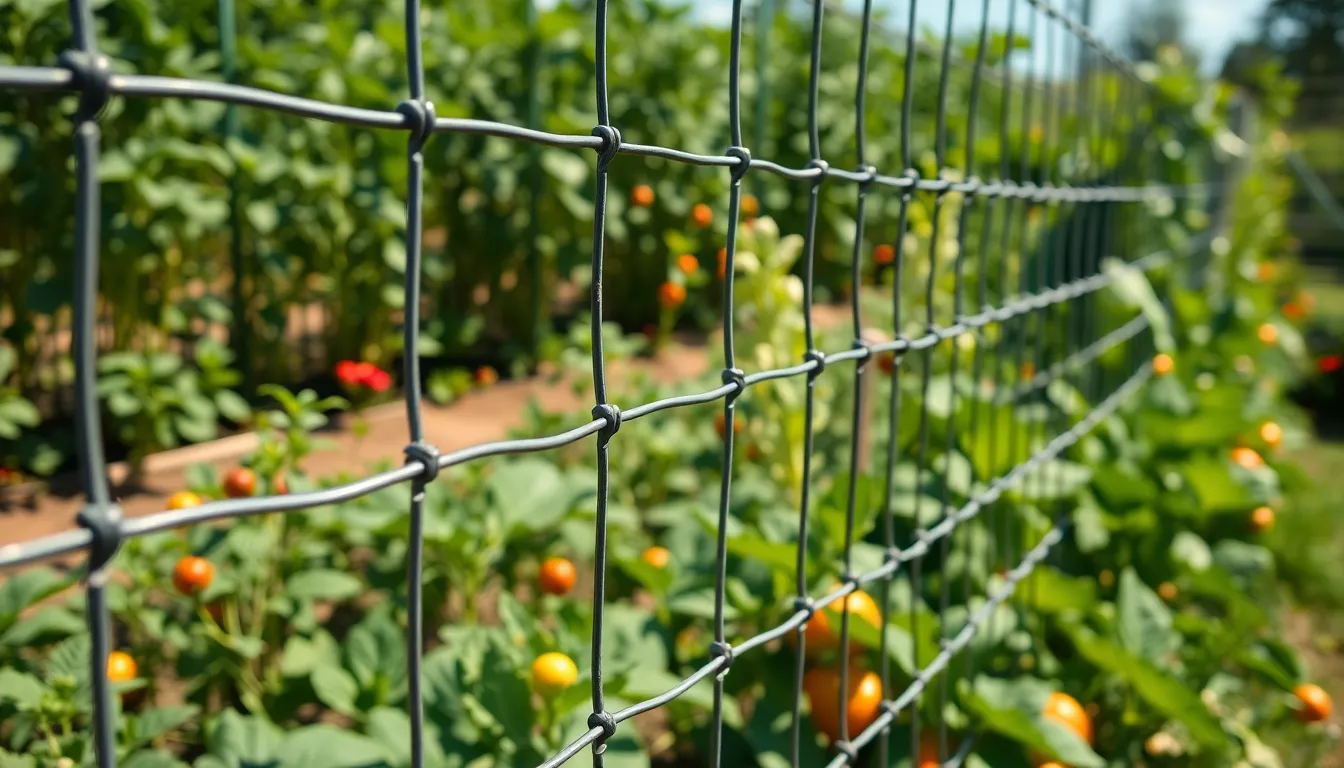
Wire and mesh fencing offers practical protection that balances security with garden accessibility. These versatile options provide excellent visibility while effectively blocking unwanted visitors from your vegetable plots.
Hardware Cloth for Small Pest Prevention
Hardware cloth delivers superior protection against the smallest garden invaders that standard fencing can’t stop. This galvanized wire mesh features tighter openings than chicken wire, making it nearly impossible for rodents, voles, and even snakes to squeeze through your garden perimeter.
Installation flexibility makes hardware cloth ideal for various garden configurations. We recommend wrapping it around raised bed frames or burying sections beneath soil level to create underground barriers against burrowing pests. The material cuts easily with wire snips, allowing you to customize pieces for any garden shape or size.
Durability ensures long term value even though the higher upfront cost compared to chicken wire. Hardware cloth maintains its structural integrity through multiple seasons and resists rust when properly galvanized.
Chicken Wire Fencing for Budget-Friendly Options
Chicken wire provides an economical entry point for gardeners seeking basic animal protection without breaking the budget. This lightweight poultry netting installs quickly with minimal tools and comes in various heights ranging from 2 to 6 feet to match your exact needs.
Effectiveness varies depending on the size of your pest problems. Rabbits and smaller birds find chicken wire challenging to navigate, but larger animals like deer can easily push through or jump over standard installations. Multiple layer applications or reinforcement with stronger materials helps address these limitations.
Mesh size options allow you to target exact pests while maintaining garden accessibility. Standard 1 inch openings work well for most small animals, while larger 2 inch spacing accommodates plant growth and garden maintenance tasks.
Welded Wire Panels for Durability
Welded wire panels offer the strongest mesh solution for vegetable gardens facing pressure from larger animals. These steel wire constructions feature welded intersections that resist bending and breaking under animal impact, providing years of reliable protection.
Installation options include standalone fence systems or reinforcement layers over existing barriers. The rigid panel structure maintains its shape better than flexible mesh alternatives, creating a more permanent garden boundary that animals learn to respect.
Long term investment value makes welded wire panels cost effective even though higher initial expenses. These panels typically last 10-15 years with minimal maintenance, making them ideal for established gardens where permanent protection justifies the upfront cost.
Living Fence Ideas Using Plants and Natural Materials
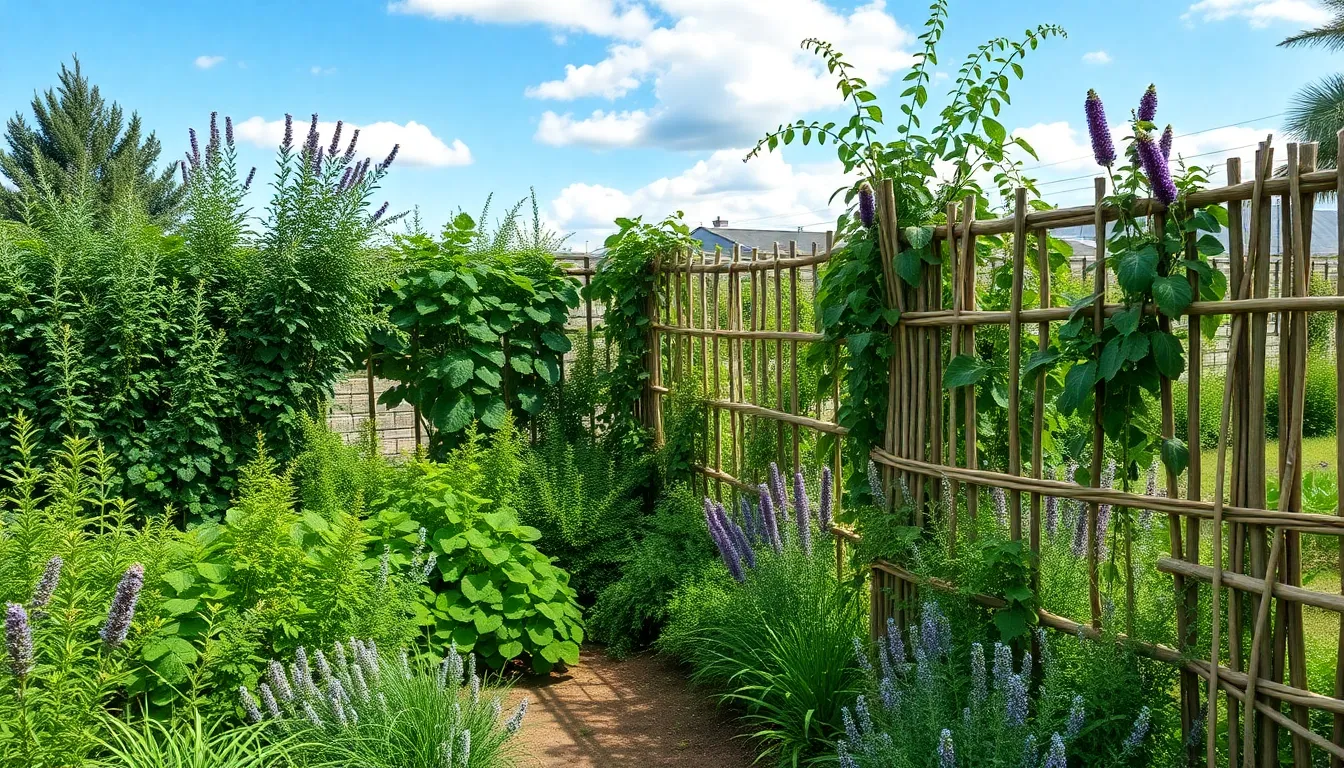
We can transform our vegetable garden boundaries into productive and beautiful living barriers that serve multiple purposes. Natural fencing answers offer sustainable alternatives while contributing to our garden’s overall network.
Hedge Rows for Edible Boundaries
Edible shrubs create functional barriers that protect our crops while providing additional harvests throughout the growing season. Rosemary hedges grow 3-4 feet tall and naturally repel many garden pests with their strong aromatic oils. Lavender plants form dense borders that reach 2-3 feet in height while attracting beneficial pollinators like bees and butterflies to our vegetable plots.
We’ll find bay leaf trees particularly effective as living fences since they can reach 6-8 feet when properly maintained through regular pruning. These Mediterranean herbs thrive in most climates and provide fresh leaves for cooking year-round. Blueberry bushes offer another excellent option for edible boundaries, producing fruit while creating 4-6 foot barriers that deer typically avoid.
Trellis Systems with Climbing Vegetables
Climbing vegetables maximize our vertical growing space while creating natural screen barriers along garden perimeters. Pole beans can reach heights of 6-10 feet when provided with sturdy trellis support, effectively blocking views and wind. Cucumber vines spread rapidly across trellis systems, producing dense foliage that creates privacy screens by midsummer.
We recommend installing 8-foot tall trellises to accommodate vigorous climbers like sugar snap peas and snow peas. These crops produce continuous harvests while filling vertical space with lush green coverage. Grape vines offer long-term living fence answers, taking 2-3 years to establish but providing decades of fruit production and natural barriers.
Willow Branch Fencing for Organic Appeal
Willow branches create flexible, woven fences that bend with wind rather than breaking under pressure. We can harvest willow shoots in late winter when they’re most pliable for weaving into decorative fence panels. Fresh willow branches maintain their flexibility for several weeks after cutting, allowing time for complex weaving patterns.
Living willow fences take root when we plant fresh branches directly into moist soil during early spring. These installations grow into permanent living barriers within one growing season, reaching 4-6 feet in height. We’ll need to trim willow fences annually to maintain their shape and prevent them from becoming overgrown thickets.
Modern Metal Fence Designs for Contemporary Gardens
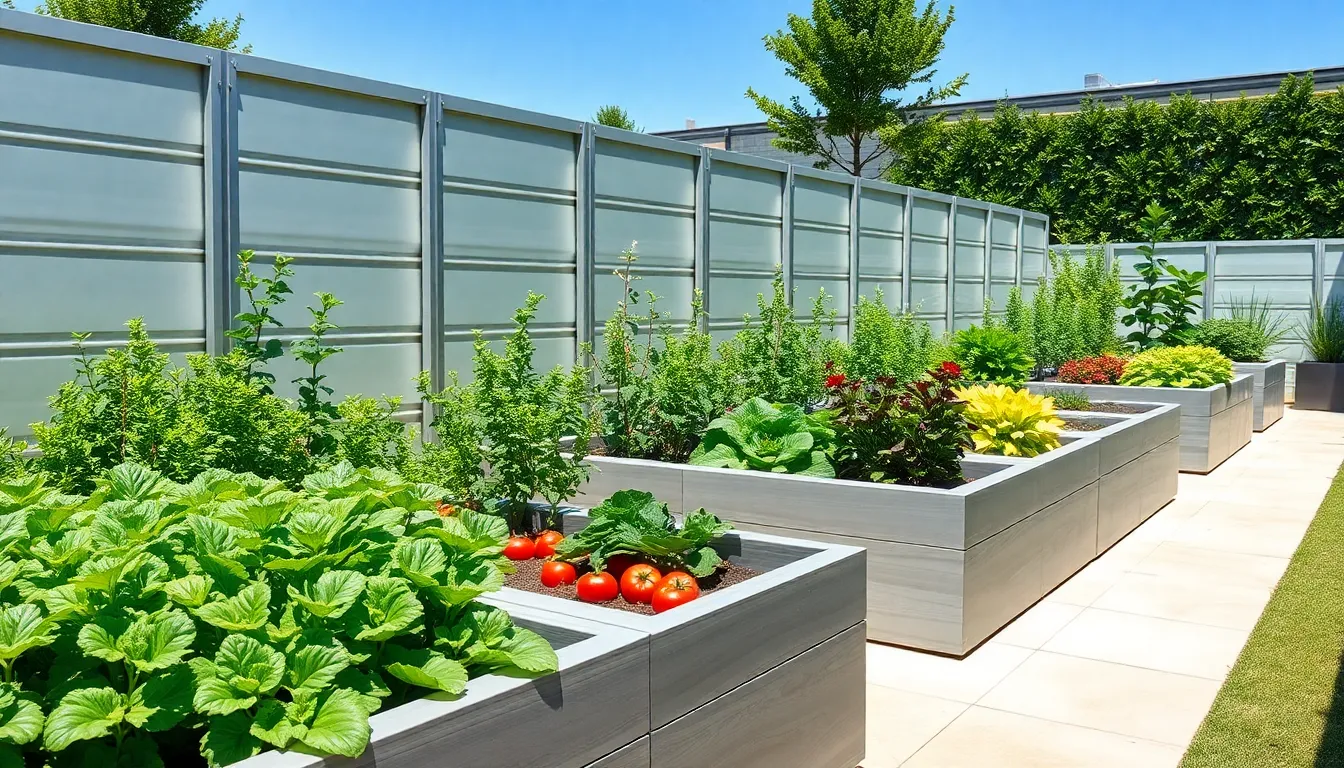
Contemporary vegetable gardens benefit from sleek metal fencing answers that combine functionality with modern aesthetics. Metal fences offer superior durability and require minimal maintenance compared to traditional materials.
Aluminum Panel Fencing for Low Maintenance
Aluminum panel fencing stands out as the top choice for busy gardeners who want maximum protection with minimal upkeep. This fencing option resists corrosion naturally and maintains its appearance for decades without painting or staining. Panels typically measure 6 feet wide and come in heights ranging from 3 to 8 feet, making them perfect for keeping out both small pests and larger animals.
Installation becomes straightforward with pre-manufactured panels that connect seamlessly to aluminum posts. We recommend choosing panels with horizontal slats spaced 2 to 3 inches apart for optimal pest control while maintaining airflow. The sleek design complements modern garden layouts and adds important property value.
Steel Wire Mesh for Industrial Style
Steel wire mesh delivers an industrial aesthetic that appeals to contemporary garden designers seeking a minimalist approach. This fencing solution provides excellent visibility while creating an effective barrier against rabbits, groundhogs, and other common garden pests. Wire openings typically measure 1 inch by 2 inches, small enough to deter most animals while allowing beneficial insects and pollinators to pass through.
Galvanized steel mesh resists rust and weathering for 15 to 20 years with proper installation. Posts require concrete footings for stability, and we suggest using 8-foot sections between posts for optimal support. The grid pattern creates interesting shadow play throughout the day, adding visual interest to your garden space.
Decorative Iron Fencing for Elegant Protection
Decorative iron fencing offers the perfect blend of sophistication and security for upscale vegetable gardens. Custom designs can incorporate ornate patterns, scrollwork, or geometric shapes that reflect your personal style while protecting crops effectively. Powder coating in black, bronze, or green provides long lasting finish that withstands harsh weather conditions.
Heights typically range from 4 to 6 feet, with spacing between vertical bars measuring 3 to 4 inches to prevent rabbit entry. Professional installation ensures proper anchoring and alignment for maximum effectiveness. The elegant appearance makes this fencing suitable for front yard vegetable gardens where aesthetics matter most.
Creative DIY Fence Ideas Using Recycled Materials
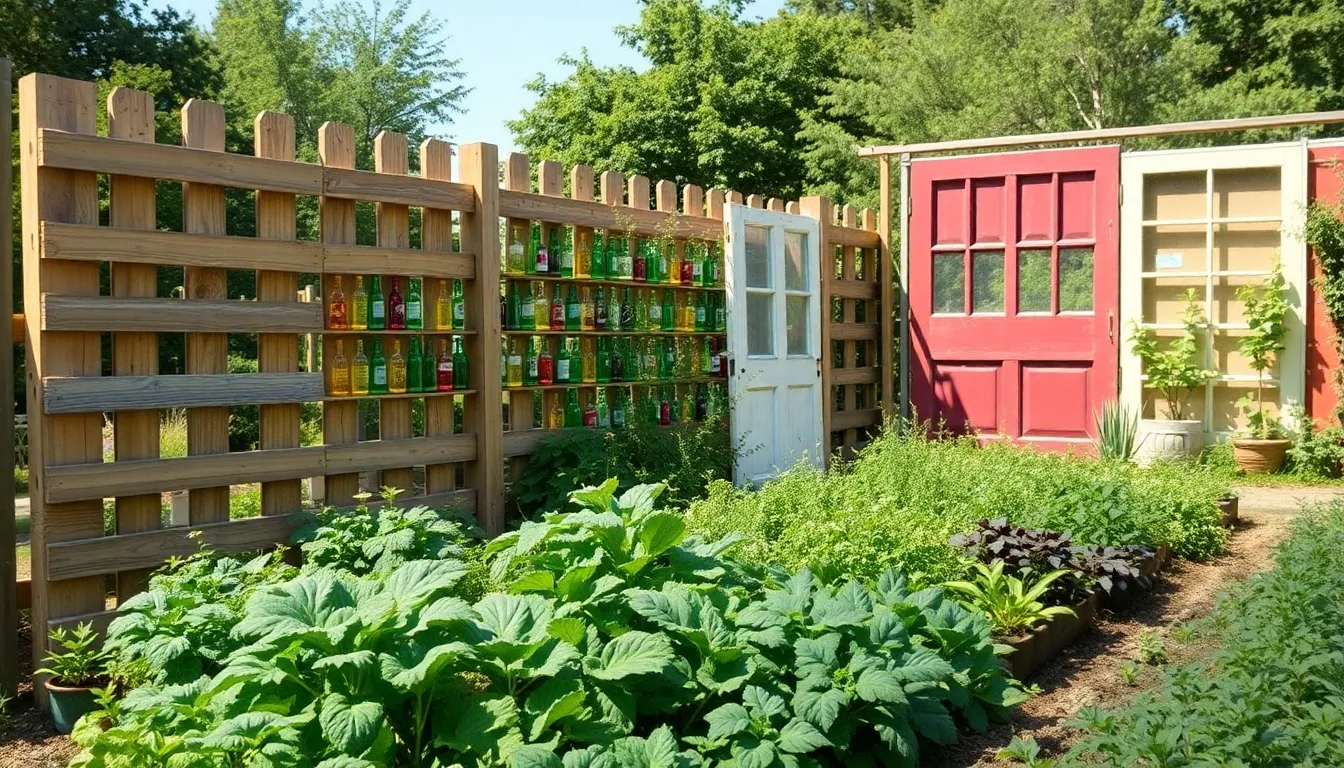
Building sustainable garden barriers doesn’t require very costly or harming the environment. We’ve discovered that repurposing everyday materials creates both functional and visually appealing vegetable garden fences.
Pallet Fence Construction for Budget Answers
Pallet fence construction offers the most cost-effective approach to protecting your vegetable garden while promoting sustainability. We recommend starting with recycled pallets, which you can often obtain for free from local businesses or shipping companies.
Materials you’ll need include:
- Recycled pallets (4-6 pallets for a 12-foot section)
- Galvanized nails or exterior screws
- Weather-resistant wood glue
- Sandpaper for smoothing rough edges
Construction process involves disassembling pallets carefully to preserve the wood integrity. Cut the pallet boards into your desired fence height, typically 4-5 feet for vegetable gardens. Assemble the boards by nailing or screwing them together vertically, ensuring proper spacing for airflow while maintaining pest protection.
This budget-friendly method typically costs 60-70% less than purchasing new materials while diverting waste from landfills. Treat the completed fence with eco-friendly wood stain to extend its lifespan to 8-12 years with proper maintenance.
Bottle Wall Fencing for Unique Barriers
Bottle wall fencing transforms discarded containers into eye-catching garden barriers that provide both function and artistic appeal. We’ve found this method particularly effective for creating shorter decorative sections within larger fencing systems.
Essential materials include:
- 50-100 plastic or glass bottles (depending on fence length)
- Heavy-duty wire mesh or chicken wire
- Wooden stakes (every 4-6 feet)
- Sand or soil for bottle filling
Installation steps require filling each bottle with sand or soil to create stability and weight. Embed the filled bottles securely within a wire mesh framework, positioning them neck-down for better drainage. Secure the entire structure using wooden stakes driven 18 inches into the ground.
This creative approach works exceptionally well for wind barriers and adds colorful visual interest to your garden space. Glass bottles create beautiful light patterns when sunlight passes through them, while plastic bottles offer greater safety around children and pets.
Repurposed Door and Window Fencing
Repurposed door and window fencing creates the most distinctive garden barriers while giving new life to architectural salvage materials. We’ve discovered that old doors and windows offer excellent structural integrity and unique aesthetic appeal for vegetable garden protection.
Required materials consist of:
- Salvaged doors and windows (various sizes)
- Treated wooden frame posts
- Heavy-duty hinges for gate creation
- Galvanized fasteners and brackets
Assembly process involves creating a sturdy wooden framework using treated posts spaced according to your salvaged materials’ dimensions. Attach doors and windows to the framework using appropriate fasteners, ensuring proper alignment and stability. Install one door section as a functional gate using heavy-duty hinges for easy garden access.
This method provides excellent protection against medium-sized pests while maintaining garden visibility and ventilation. The varied heights and styles of salvaged materials create an eclectic, cottage-garden aesthetic that complements traditional vegetable growing spaces perfectly.
Temporary and Portable Fence Options for Flexible Gardening
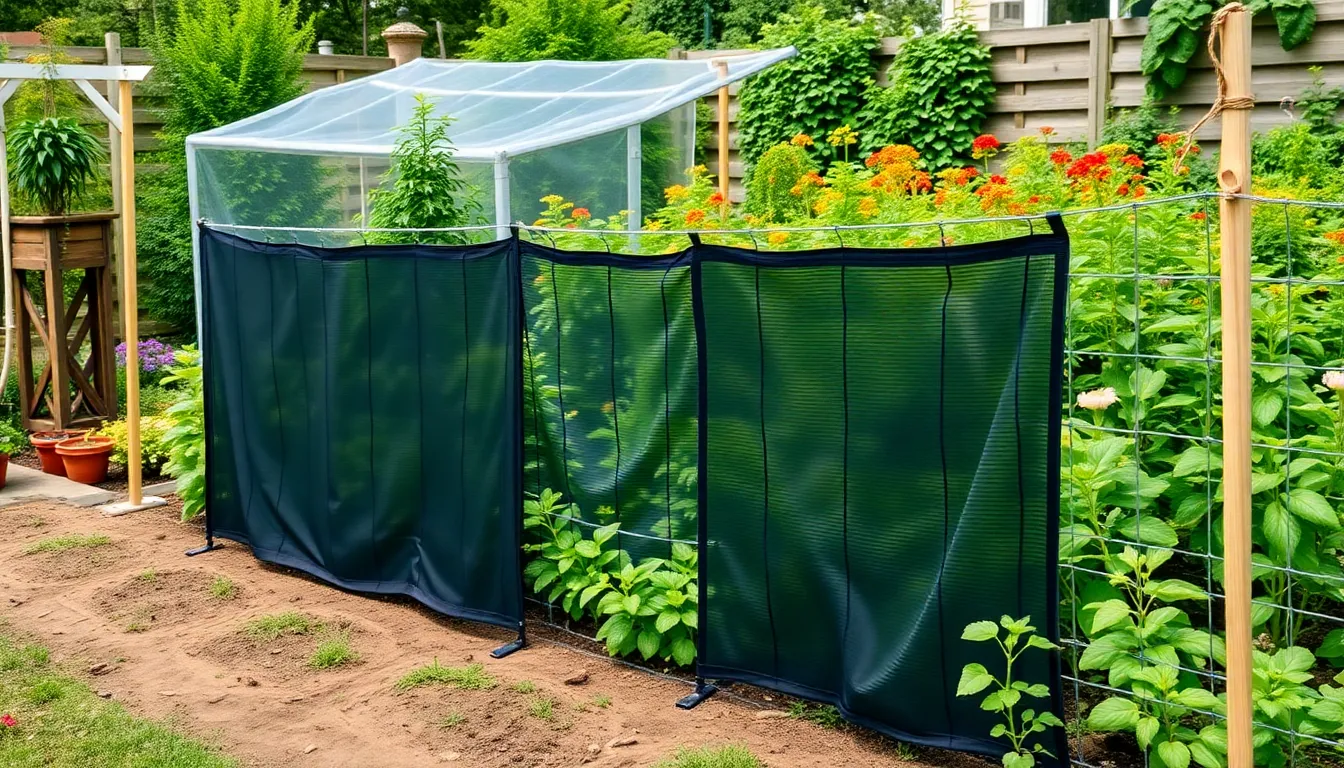
Flexibility becomes essential when you’re planning a vegetable garden that needs to adapt to changing seasons or layouts. We’ve found that temporary fencing answers offer the perfect balance between protection and adaptability for modern gardeners.
Removable Panel Systems for Seasonal Use
Removable panel systems offer the most versatility for gardeners who need seasonal protection without permanent installation. These pre-built panels slot easily into place and can be removed when the growing season ends. We recommend choosing panels made from wood, metal, or lightweight plastic materials that provide durability while remaining easy to handle.
Assembly takes minutes rather than hours with these systems since they’re designed for quick setup. Panel heights typically range from 3 to 6 feet depending on your exact pest protection needs. Storage becomes simple during off-seasons as panels stack neatly in sheds or garages.
Adjustment capabilities allow you to modify fence configurations as your garden layout changes from year to year. Cost effectiveness improves over time since panels can be reused for multiple growing seasons with proper care.
Folding Screen Fences for Easy Storage
Folding screen fences feature hinged panels that collapse accordion-style for compact storage when not needed. These screens are commonly constructed from wood frames with coated chicken wire or mesh inserts that provide effective pest barriers. We’ve observed that folding screens work particularly well for gardens with limited storage space.
Installation requires no tools since most folding screens are designed to stand independently or stake into soft ground. Portability makes these fences ideal for renters or gardeners who frequently relocate their growing areas. Weather resistance varies by material but wooden frames with wire mesh typically last 5-8 years with basic maintenance.
Flexibility allows you to create curved or angled fence lines that follow natural garden contours. Storage footprint reduces to just a few inches when panels are fully folded for winter storage.
Stakes and Netting for Quick Installation
Stakes and netting systems provide the fastest installation method for temporary garden protection. Lightweight metal or plastic stakes press directly into garden soil without digging post holes or mixing concrete. We recommend this approach for short-term plant protection during critical growth periods.
Installation speed allows you to protect vulnerable seedlings within 15-20 minutes for average-sized garden plots. Material costs remain minimal since basic stakes and bird netting or deer mesh are among the most affordable fencing options available.
Versatility enables you to create custom fence heights and shapes by adjusting stake placement and netting tension. Removal takes just minutes when you need to access plants for harvesting or maintenance tasks.
Storage requirements are minimal as stakes nest together and netting rolls into compact bundles. Reusability makes this system cost-effective since quality netting can protect gardens for 3-5 seasons with careful handling.
Height Considerations for Effective Garden Fencing

Choosing the right fence height dramatically impacts both protection effectiveness and garden aesthetics. We’ve found that matching fence height to your exact pest challenges creates the most successful vegetable garden barriers.
Low Fences for Decorative Borders
Picket fences work perfectly for gardens where decoration takes priority over heavy pest protection. These charming barriers typically stand 3-4 feet tall and allow excellent visibility while maintaining air circulation throughout your vegetable beds. Wood or metal construction options give you flexibility in matching your garden’s existing design elements.
Recycled pallet fences offer sustainable gardeners an eco-friendly alternative that stays budget conscious. Repurposing wooden pallets creates attractive low barriers that you can customize with paint or stain to complement your industry. We recommend this option for gardeners dealing with minimal pest pressure who want to add rustic charm to their growing space.
Medium Height Fences for Animal Deterrence
Wood and wire fences provide the sweet spot for most vegetable gardens facing small animal challenges. Standing 4-5 feet tall, these hybrid barriers combine wooden posts with wire mesh to effectively block rabbits and groundhogs from accessing your crops. This height range offers protection without creating an imposing visual barrier in your yard.
Rustic picket fences deliver both decorative appeal and practical animal deterrence for medium sized gardens. These variations of traditional picket designs feature weathered wood finishes that complement natural garden settings while providing adequate height to discourage common garden pests. We’ve seen these fences work particularly well in cottage style vegetable gardens.
Tall Fences for Maximum Security
Deer fences stand as the ultimate solution for gardens in areas with large wildlife populations. Reaching 6-8 feet in height, these specialized barriers use metal or high tensile wire construction to create an effective deterrent against deer and other large animals. The important height investment pays off when you consider the damage deer can inflict on an entire season’s harvest.
Privacy fences combine maximum security with complete visual screening for your vegetable garden. Standing 6 feet or taller, these substantial barriers protect against all pest sizes while shielding your growing space from neighbors and passersby. We recommend privacy fencing for urban gardeners who want both pest protection and personal garden sanctuary.
Conclusion
Choosing the right fence for your vegetable garden doesn’t have to be overwhelming. We’ve explored many options that balance protection effectiveness with visual appeal – from traditional cedar and bamboo to modern aluminum panels and creative DIY answers using recycled materials.
Remember that the best fence combines your exact pest challenges with your garden’s aesthetic goals and maintenance preferences. Whether you opt for a temporary portable solution or invest in a permanent living fence we’re confident you’ll find the perfect match for your growing space.
The key is matching fence height and material to your local wildlife while considering factors like budget installation time and long-term durability. With proper planning your garden fence will protect your harvest while improving your outdoor space for years to come.
Frequently Asked Questions
What is the best fencing material for protecting vegetable gardens from pests?
Cedar picket fencing is considered the top choice due to its natural pest-resistant properties. At 4 feet high with 2-inch spacing, it effectively deters rabbits while allowing proper airflow. Cedar requires minimal maintenance and can last 15-20 years with proper care, making it both practical and cost-effective for long-term garden protection.
How high should a garden fence be to keep deer out?
For effective deer protection, fences should be 6-8 feet tall. Deer are excellent jumpers and can easily clear shorter barriers. If you’re using split rail fencing, combine it with wire mesh to create adequate height and coverage for maximum deer deterrence.
What’s the most budget-friendly fencing option for small gardens?
Chicken wire is the most budget-friendly option for protecting against smaller animals like rabbits and rodents. While it’s less effective against larger pests like deer, it provides adequate protection for most common garden invaders at a fraction of the cost of other materials.
Can I use recycled materials to build an effective garden fence?
Yes, recycled pallets make excellent DIY garden fences. They’re budget-friendly, environmentally sustainable, and can be easily customized for your garden’s specific needs. Other creative options include bottle walls and repurposed doors or windows, which add unique visual appeal while providing effective pest protection.
What are the benefits of living fences for vegetable gardens?
Living fences using plants like rosemary, lavender, and bay leaf trees provide dual functionality – pest protection and additional garden produce. These natural barriers attract beneficial pollinators, enhance garden aesthetics, and create sustainable, long-term solutions that improve over time rather than deteriorate.
Are temporary fences effective for seasonal garden protection?
Temporary fences are highly effective for seasonal protection and offer excellent flexibility. Removable panel systems, folding screens, and stakes with netting provide quick installation and easy storage. They’re perfect for renters, experimental gardeners, or those who need to adjust their garden layout frequently.
What’s the difference between hardware cloth and chicken wire?
Hardware cloth features smaller, tighter openings than chicken wire, making it superior for preventing small pests from entering your garden. While chicken wire is more budget-friendly, hardware cloth offers better protection and greater installation flexibility for various garden configurations and pest challenges.
How do I choose between wooden and metal fencing for my garden?
Choose wooden fencing (like cedar) for natural aesthetics and pest resistance, ideal for traditional garden styles. Select metal options (aluminum or steel) for low maintenance, durability, and modern appeal. Consider your garden’s style, maintenance preferences, and local pest pressure when making your decision.

